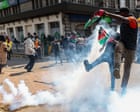
In a serene reflection on recent developments in Kenya, the nation rallied together to commemorate the first anniversary of a historic event: the storming of its parliament by passionate citizens. This observance, intended as a peaceful demonstration of remembrance, has instead unfolded into a more complex tableau, underscored by unintended tensions and a poignant expression of collective memory.
The marches occurring nationwide were primarily dedicated to honoring individuals who had tragically lost their lives during last year’s anti-government protests. These marches, seemingly harmonious in intent, met with unexpected turbulence, reaching a crescendo as police forces engaged with demonstrators in various regions, including the bustling heart of Nairobi. Regrettably, these interactions resulted in the loss of 16 lives and left approximately 400 participants injured, marking a sorrowful outcome to an event borne out of memorial.
Amnesty International Kenya, through its esteemed Executive Director, Irũngũ Houghton, confirmed these figures, substantiating their legitimacy with insights provided by the government-backed Kenya National Commission on Human Rights. Houghton noted that many of the fatalities were a result of police actions, reflecting the stark challenges of law enforcement during such emotive gatherings.
Amidst the unfolding occurrences, images emerged from the Nairobi city center, portraying scenes where law enforcement utilized measures such as teargas and water cannons to manage the throngs of demonstrators. These tools, standard in crowd control, speak to the tensions that spark when the foundational ideals of safety and expression intersect.
Despite the physical and emotional toll, the anniversary marches were emblematic of a deeper cultural dialogue within Kenya. Civil and human rights advocates, alongside family members of those who sustained losses, engaged in spirited mobilizations both online and in physical spaces. These populations, coupled with energetic youth contingents, drove the momentum of the protests, bolstered in part by vocal opposition leaders. Such figures declared the day a “people’s public holiday,” while government representatives issued advisories against any disturbances that might breach public peace.
This confluence of commemoration and resistance underscores Kenya’s ongoing journey towards reconciling civic engagement with governance structures. The outcomes of these events have reiterated the crucial role that dialogue, understanding, and empathy hold in navigating public assemblies. Ensuring that future actions honor their intended spirit—without crossing into discord—is a shared responsibility, as the nation continues its path of evolution and reflection.
In closing, even amidst the ripples of unrest, the essence of these protests is anchored in the national heart—a meditative commitment to acknowledging history while gently steering towards a harmonious tomorrow.
Source: {link}
